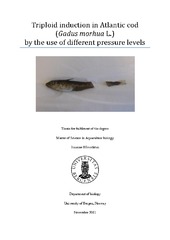Triploid induction in Atlantic cod (Gadus morhua L.) by the use of different pressure levels
Master thesis
Permanent lenke
http://hdl.handle.net/1956/5572Utgivelsesdato
2011-10-31Metadata
Vis full innførselSamlinger
Sammendrag
In the present experiment, different levels of pressure were investigated to see if it was possible to induce triploidy at a lower pressure level than previously used for Atlantic cod (Gadus morhua). Newly fertilized eggs (offspring of one male and one female), were exposed to different levels of pressure and accordingly divided into four experimental groups: 400, 500 and 600 bar, and one control group. Each pressure group received the desired pressure for 5 min, beginning at 180 ºC min post-fertilization. Induction of triploidy occurred at each pressure level used in this experiment. Blood cell diameter analysis showed that pressure treatment had an effect on blood cell diameter; resulting in increased mean blood cell diameter that was correlated with increasing pressure level used. Furthermore, microsatellite loci analysis revealed over 90 % triploid outcome in each experimental group, whereas the remaining part could not be identified as triploids. Overall this study demonstrated successfully triploid induction at both low (400 bar) and medium (500 bar) pressure. Further studies are recommended in order to reveal the optimal pressure level for triploid induction in Atlantic cod in accordance with less severe deformities, reduced effect of sexual maturation, high growth rate and a high flesh quality. This, in combination with all-female production, will potentially be a promising approach for triploidy in large-scale aquaculture production.
